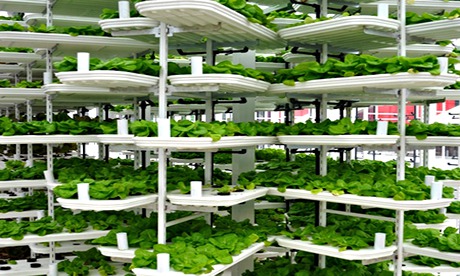Growing food in population centres would increase yields, cut transport costs and overcome limited land area
The Observer, Thursday 6 February 2014 10.30 GMT

Vertical farming overcomes a limited land area. Photograph: Observer
Populations are growing and cities are booming – but could we soon see skyscrapers turned into centres for crop production? From Chicago warehouses to the south pole growth chamber in Antarctica, the concept of growing food indoors is catching on. Plant scientist Dr Erik Murchie, from the University of Nottingham, reveals how agriculture could be turned on its head.
What is vertical farming?
It's vertical because you are trying to grow more crops on a smaller land area and this usually means going upwards into buildings. It normally means that, instead of having a single layer of crops over a large land area, you have stacks of crops going upwards. It's also associated with city farming and urban farming.
Why do we need it?
It is the need to increase crop yield without increasing the land area for crops. If we can move some of that away from the countryside into the city, and get some of that food production close to the high concentrations of population, then we can make a real impact. People want to do it as well – it puts the food supply in the control of people living in the cities.
How high are we talking – skyscrapers?
The beauty of vertical farming is that you can go as high as you want – if you have a system that works efficiently. The only risk with that is getting things that plants need like water and nutrients up there. And you need a way of getting your product out efficiently.
Can we grow all crops like this?
Wheat, maize and rice – these things that provide the bulk of our calories- will be very difficult to grow on a vertical farm because you need to accumulate a massive biomass for those crops - you might expect typically anything between 5 and 12 tonnes per hectare of grain from something like wheat, but to do that you have to accumulate upwards of 20 tonnes per hectare of dry weight of plant. So it's the weight of the plant. The crops that are likely to be grown are high-value nutritious crops – like tomatoes, lettuces, green crops.
What's holding us back?
Energy will be the great limiting factor for this. Plants need a lot of light for photosynthesis. There's a couple of examples in the US of warehouses being converted into stacks of plants. They use LED lights which are cool, efficient lights you can put close to the plants. They are very efficient at making plants grow and you can control plant growth very well, but again you need energy to do that.
How do you see this developing?
What will drive it is technology – the technology to have new buildings, or convert old buildings, where you can have high concentrations of plants; where you can get enough light in there for the plants to grow, and have the recycling of water and nutrients.
You don't need soil for this, you can do it hydroponically. It's good to keep soil out of it, then you can keep it clean and control the nutrient cycling and water cycling very efficiently. There is plenty of opportunity for biological control of pests and diseases.

No comments:
Post a Comment